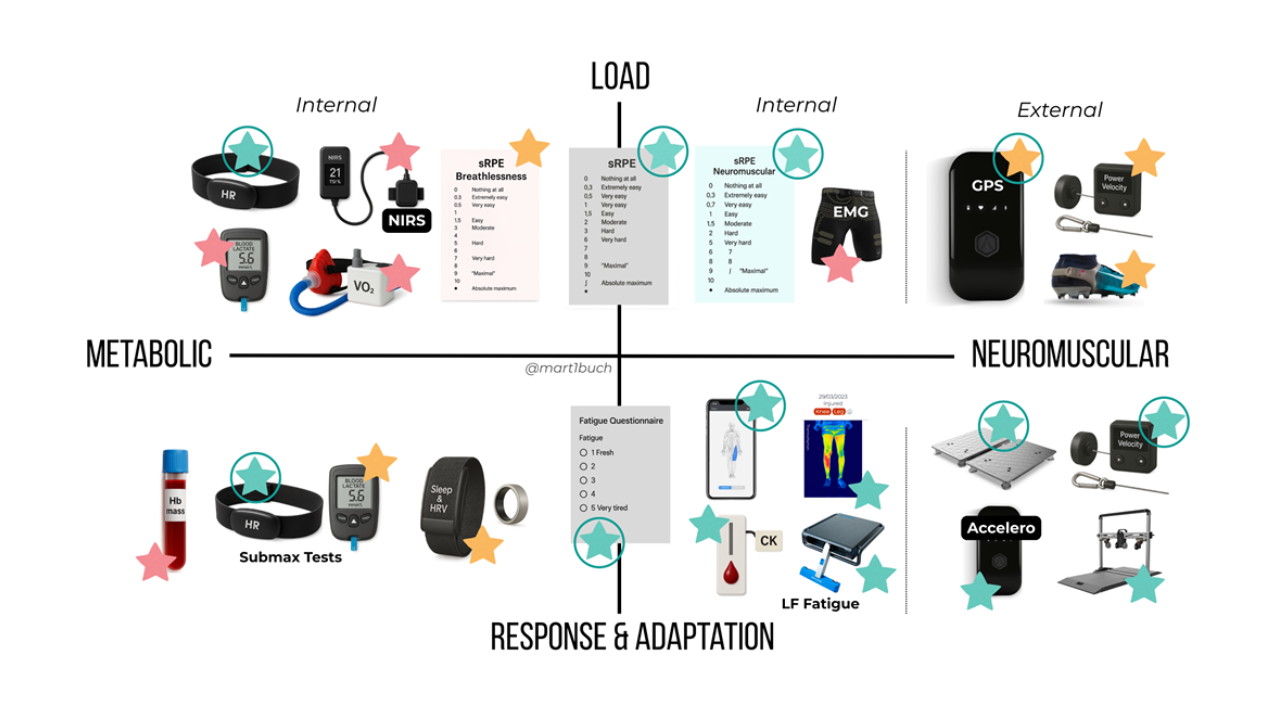In the world of high-performance sport, especially elite football, there’s more data than ever before.
GPS metrics, heart rate variability, jump heights, player load scores, and more.
But here's the problem: more data doesn’t mean better decisions.
Despite advances in technology, most teams still struggle to answer a critical question:
“How is the athlete actually responding to training?”
A new paper (1) by Martin Buchheit offers a refreshingly simple and powerful solution: a quadrant-based model that maps your tools to the right purpose.
Let’s break it down.
The Problem: Load ≠ Response
Most monitoring systems focus almost entirely on external load, or what the athlete does:
- Distance covered (via GPS)
- Speed, acceleration
- Heart rate during training
- RPE scores
However, what is often missing is how the athlete responds to that load.
Did they adapt? Are they fatigued? Are they improving?
The 4 Quadrants Every Coach Needs to Monitor
Buchheit introduces a framework built on two simple axes:

- Input vs. Output
- Load = the work done
- Response = how the body reacts
- Metabolic vs. Neuromuscular Systems
- Metabolic = cardiovascular, energy system
- Neuromuscular = muscle, tendon, movement strain
Together, they create 4 quadrants you should monitor:
| Load (Input) | Response / Adaptation (Output) | |
|---|---|---|
| Metabolic System | HR, lactate, sRPE-breath | Submax HR, HRV, aerobic fitness tests |
| Neuromuscular System | GPS, accelerometers, sRPE-neuro | Jump tests, soreness scores, CK, isometrics |
Why GPS (or LPS) Alone Isn’t Enough
GPS and LPS for indoor sports is the darling of modern team sports, but it’s often misunderstood.
- It tells you what happened on the field or court (e.g., high-speed running).
- But it can’t tell you how an athlete’s muscles, tendons, or nervous system are responding.
- Worse, coaches often treat GPS numbers as "targets," when in reality, movement is a result of tactics, not the goal itself.
The Forgotten Tools: HR and sRPE
Heart rate monitoring was once a staple of sport science.
Now it’s often left behind in favor of shinier toys.
But HR is still one of the most practical ways to monitor metabolic load, especially when combined with RPE or submax testing.
Likewise, differential RPE (e.g., breathlessness vs. muscular strain) is a simple yet underutilized method for understanding session demands.
Minimum Monitoring Setup
Here’s a practical, cost-effective monitoring system that hits all four quadrants:
Metabolic Load
- Heart Rate or sRPE (Breathlessness)
- Low-cost and widely applicable
Neuromuscular Load
- GPS (with understanding of its limits)
- sRPE (Muscle strain)
Metabolic Adaptation
- Submax HR testing during standardized runs
- HRV (context-dependent)
Neuromuscular Adaptation
- Jump tests (CMJ) or isometric strength tests
- Muscle soreness ratings
Context and Compliance
The most effective monitoring system is the one that you can actually implement.
- Don’t measure everything: Measure what matters and what you’ll actually use.
- Pick your battles: Maybe you track HR on only two key days per week.
- Monitoring during return-to-play: Can and should be more intensive and individualized.
As Buchheit notes: “This is no longer about missing tools—it’s about missing structure and physiological common sense.”
Coach's Takeaways
- Stop confusing load with response.
- Use the right tools for the right quadrant.
- Only collect data that will inform a decision.
- Get athlete buy-in through education and consistency.
- Less tech, more clarity.
Reference
- Buchheit, M., & Hader, K. (2025). A quadrant-based model for monitoring elite footballers. Sports Performance & Science Reports, 258, 1–14.




